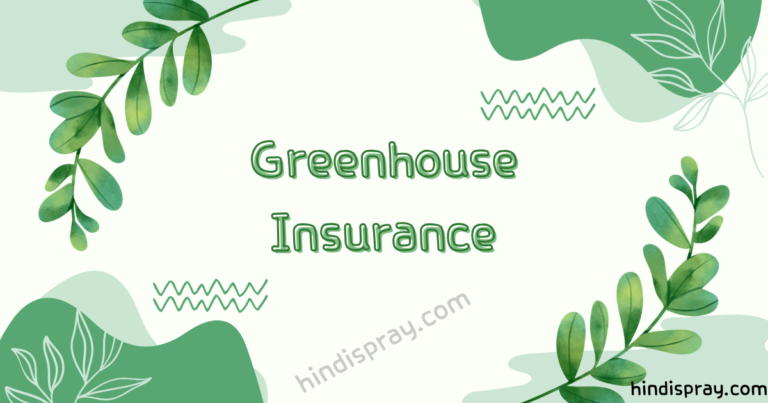Greenhouses are essential for many farmers and gardeners, providing a controlled environment for plant growth. However, they are also vulnerable to various risks, including extreme weather, pests, fire, and equipment failure. Greenhouse insurance is designed to protect against these risks, ensuring financial security in case of damage or loss.
Understanding Greenhouse Insurance
What Is Greenhouse Insurance?
Greenhouse insurance is a specialized type of coverage designed to protect greenhouse structures, crops, equipment, and business operations from potential risks. This insurance provides financial compensation in case of unforeseen events, helping greenhouse owners recover losses.
How Does Greenhouse Insurance Work?
Greenhouse insurance works similarly to other property insurance policies. Policyholders pay a premium based on the coverage they choose. If an insured event occurs, such as storm damage or fire, the insurance company compensates the policyholder according to the terms of the policy.
Types of Greenhouse Insurance Coverage

1. Property Coverage
This covers physical damage to the greenhouse structure due to storms, hail, fire, vandalism, or other disasters. It ensures that repairs or replacements can be made without financial strain.
2. Crop Insurance
Since greenhouses house valuable plants, crop insurance covers losses caused by diseases, pests, or environmental factors. This coverage is essential for commercial greenhouse operators.
3. Equipment Insurance
Greenhouses rely on heating, cooling, and irrigation systems. Equipment insurance protects against damage or breakdowns, ensuring that operations continue smoothly.
4. Business Interruption Insurance
If a covered event causes a temporary shutdown of greenhouse operations, business interruption insurance compensates for lost income, helping owners stay financially stable.
5. Liability Insurance
Greenhouse owners may face liability claims from employees, visitors, or customers. Liability insurance covers medical expenses and legal fees if someone gets injured on the property.
Why Do You Need Greenhouse Insurance?
1. Protection Against Natural Disasters
Storms, hail, floods, and fires can destroy greenhouses. Insurance ensures that these disasters don’t result in a total financial loss.
2. Safeguarding Investments
Building and maintaining a greenhouse requires significant investment in structures, crops, and equipment. Insurance protects these assets.
3. Ensuring Business Continuity
Unexpected disruptions can halt greenhouse operations. Business interruption coverage ensures that revenue loss doesn’t cripple the business.
4. Legal Protection
If someone gets injured on the property, liability insurance covers legal expenses and medical costs, protecting greenhouse owners from lawsuits.
Factors To Consider When Choosing Greenhouse Insurance
1. Coverage Options
Assess the types of risks your greenhouse faces and choose coverage that matches your needs.
2. Premium Costs
Compare insurance providers and premium rates to find an affordable policy that offers comprehensive coverage.
3. Exclusions and Limitations
Read the policy carefully to understand what is excluded. Some policies may not cover certain natural disasters or require additional riders.
4. Reputation of the Insurance Provider
Choose an insurer with a strong reputation for handling claims efficiently and providing excellent customer service.
5. Customization Options
Look for policies that allow customization to meet specific needs, such as additional coverage for rare plant species or specialized equipment.
How To File A Greenhouse Insurance Claim
Step 1: Assess the Damage
After an incident, inspect the greenhouse and document all damages with photos and written descriptions.
Step 2: Contact Your Insurance Provider
Notify your insurer as soon as possible. Provide them with details of the damage and any supporting documentation.
Step 3: Work With an Adjuster
An insurance adjuster will assess the damage and determine the compensation amount.
Step 4: Receive Compensation
Once the claim is approved, you will receive payment to cover repairs, replacements, or business losses.
Also Read: What Is Commercial Vehicle Insurance And Why Do You Need It?
Conclusion
Greenhouse insurance is a crucial investment for anyone operating a greenhouse. It protects against natural disasters, equipment failures, and financial losses, ensuring that greenhouse businesses remain stable. Choosing the right policy requires careful consideration of coverage options, costs, and exclusions.
FAQs
1. Is greenhouse insurance mandatory?
No, but it is highly recommended to protect against potential losses and business disruptions.
2. How much does greenhouse insurance cost?
Costs vary based on coverage options, location, and the size of the greenhouse. Getting quotes from multiple insurers can help find the best rate.
3. Does greenhouse insurance cover plant diseases?
Some policies include crop insurance, which covers plant diseases. Always check the policy details to confirm coverage.
4. Can I customize my greenhouse insurance policy?
Yes, many insurers offer customization options to cover specific risks, such as rare plants or specialized equipment.
5. How quickly can I get compensated after filing a claim?
The processing time varies but usually takes a few weeks, depending on the complexity of the claim and the insurer’s response time.

